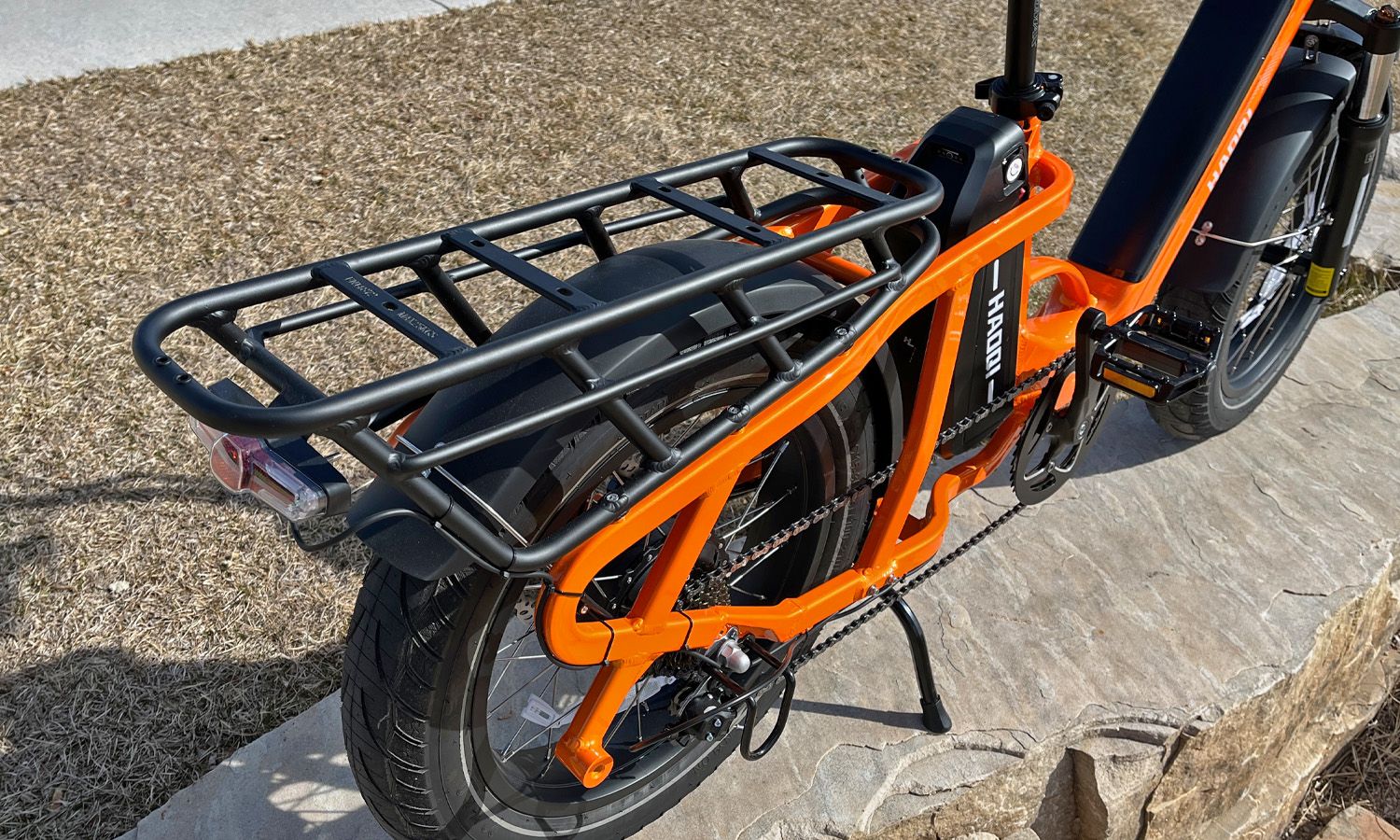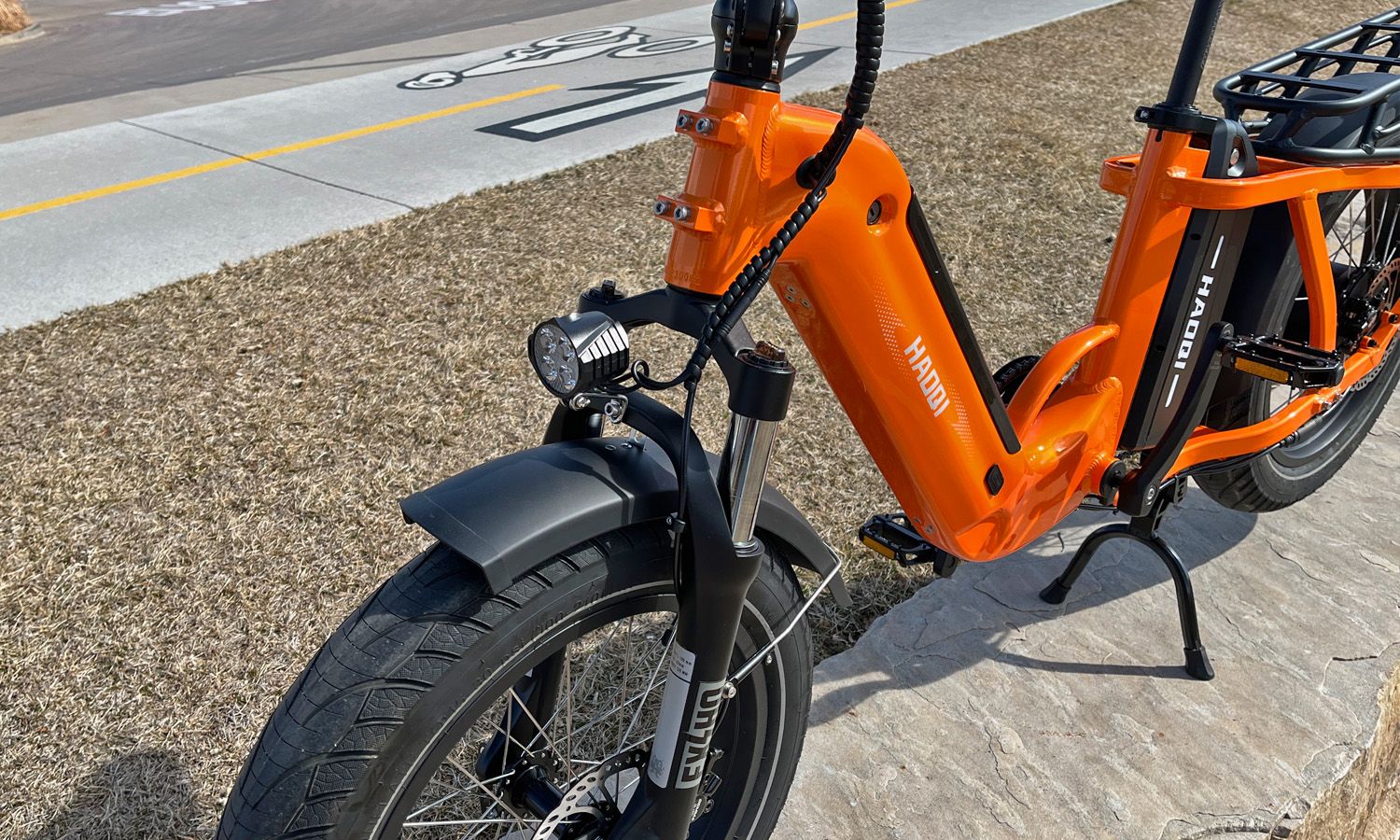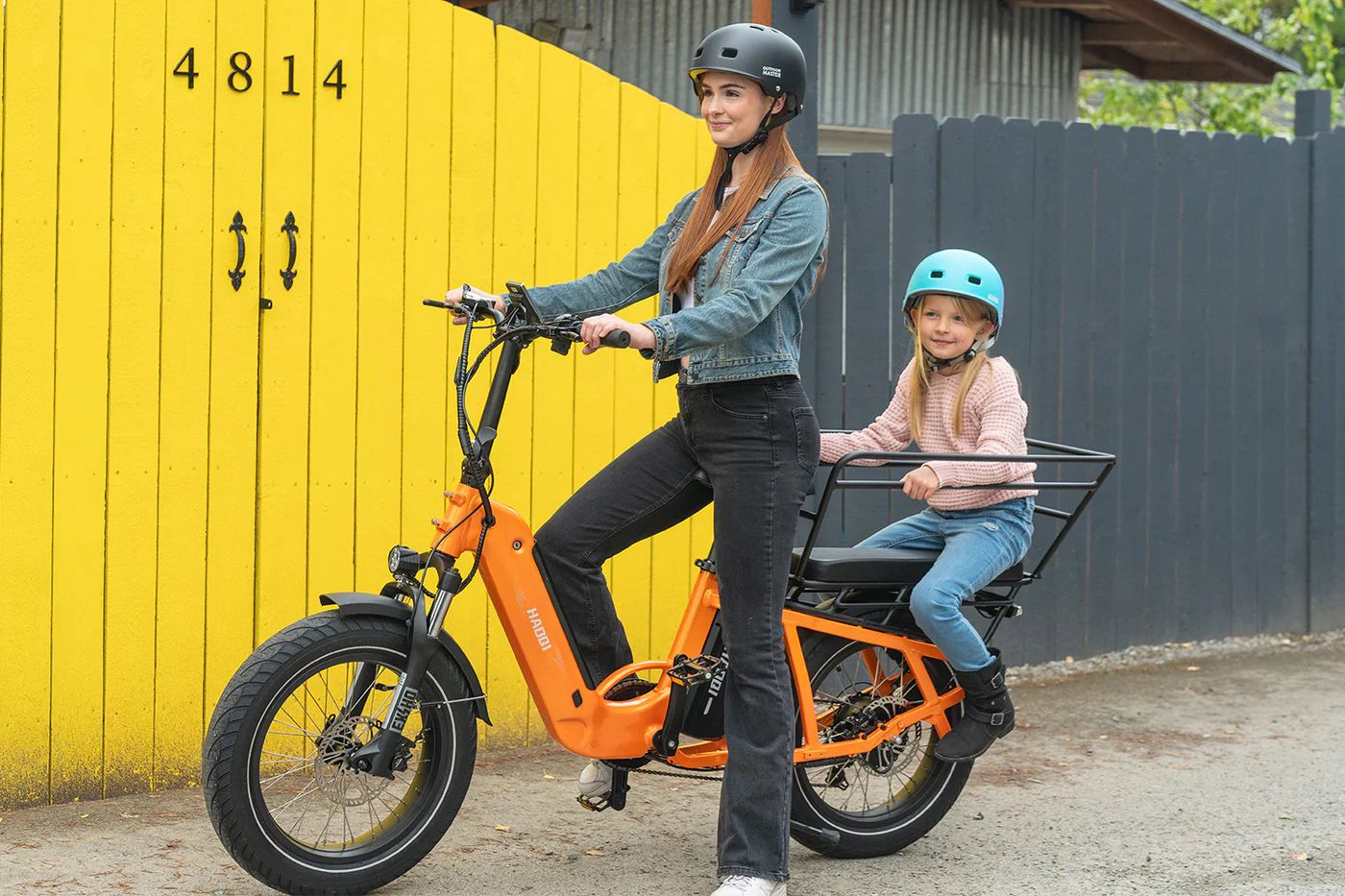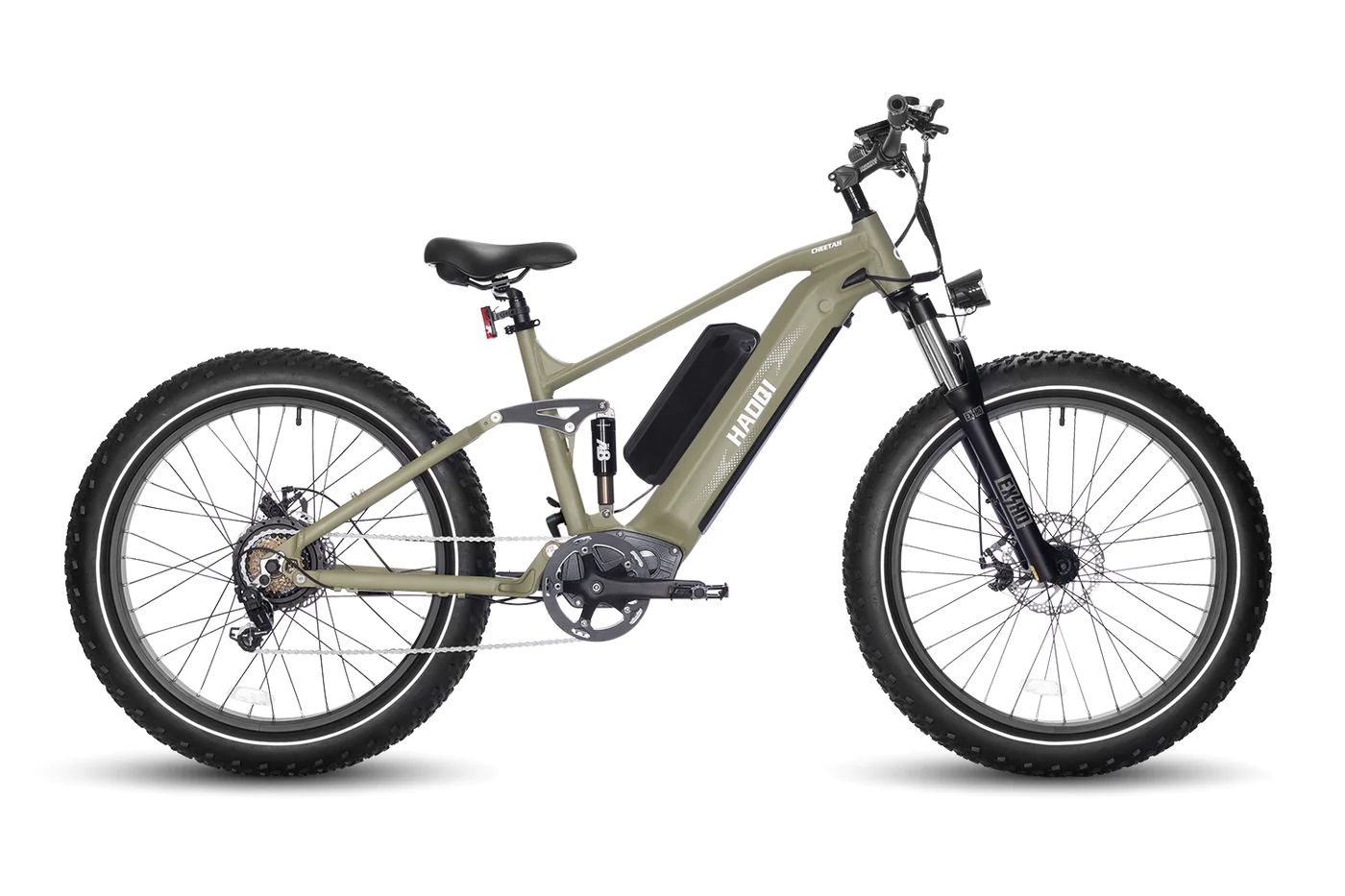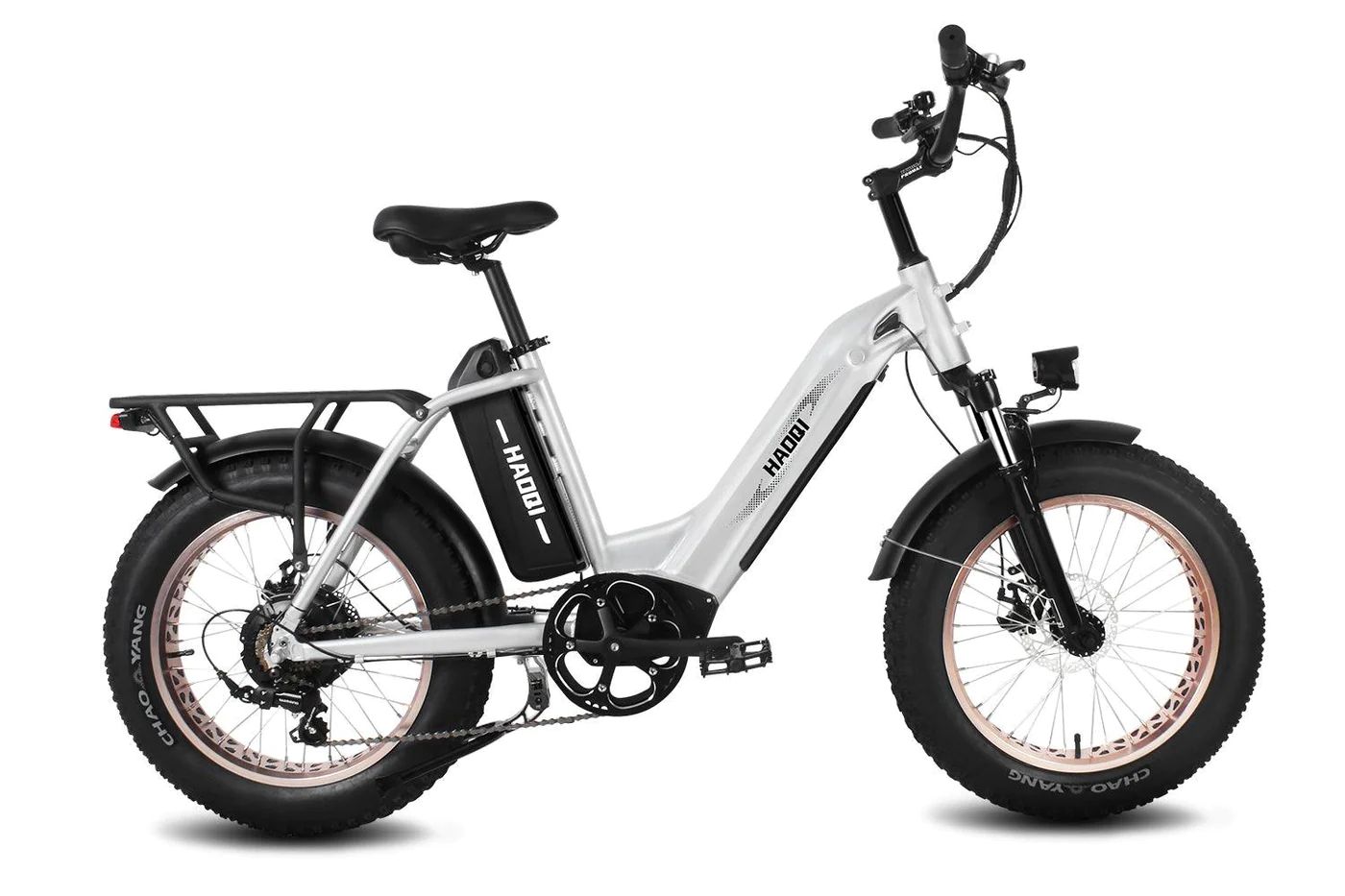The Haoqi Camel has a lot of value packed in for just $1,699, especially when you realize it's a dual battery setup! It has a sturdy frame ready for serious cargo hauling, integrated lighting and a loud horn, and can be operated via throttle or pedal assist up to 20 mph.
Design & Build Quality
The Camel is a heavy-duty cargo hauler, sturdily built and with a payload capacity of 450 lbs (204 kg), which is near the high end of the range for good cargo bikes. It's more approachable than the average cargo hauler too, thanks to the low step-through frame, smaller 20" wheels, and a relatively short wheelbase. It's easy to mount and dismount, doesn't take up too much space when stored, especially since the stem can be quickly folded down.
One downside is that the Camel doesn't come with any cargo-related accessories by default. There's plenty of mount points for adding racks, guard rails, running boards, a front basket, foot pegs, and pretty much anything else you can think of... but you'll have to pay extra for those if you get them from Haoqi. I can understand their logic, because depending on your use case the accessories are going to be quite different (imagine hauling your two kids around vs. delivering groceries for Instacart). Good accessories can be had pretty cheaply at most local bike shops too, and modding these bikes out is actually quite fun!
Overall the Camel feels quite polished. Electronics are cleanly integrated, controls are intuitively laid out on the grips, and it was relatively easy to set up and get riding. It is a hefty bike, so you might want a second person on hand to help with mounting the front wheel.
The Electronics Have Room for Improvement
The various electronic components on the Haoqi Camel are a mixed bag; most things are done very well, but the pedaling drivetrain has some room for improvement. Let's start with the good: the integrated lights are powerfully bright with flashing brake light activation, turn signals, and an obnoxiously loud horn. This is a great safety touch, and I love that the signal controls have a standard motorcycle-style layout on the left grip.
The Camel is also rocking dual batteries, which is pretty wild for this price range! I was skeptical about the quality of the batteries, especially since Haoqi does not mention safety certifications anywhere on their website... but their marketing rep assured me by email that yes, they are UL certified. Haoqi also has a three-year battery replacement program which is great for peace of mind. You can pilot the Camel with one or both batteries equipped, with both giving you a range of between 80-120 miles (129-193 km) depending on riding conditions. While you probably won't ever go that far in a single ride, it's nice to be able to ride multiple days in a row before you need to recharge. The only downside is that this is a pretty hefty e-bike with both batteries equipped, weighing in at about 87 pounds (39.5 kg), with around 20 of that being just the batteries. Definitely take them off for easier transport and storage!
The pedaling drivetrain is really the one weak spot for the Camel. There are a few factors at play here: For starters, it's a cadence sensor, which only measures pedal rotations and has a significant delay when starting and stopping. Torque sensors are much more responsive, and no longer an expensive upgrade, so I'd love to see one on the Camel. The pedaling hardware is the most basic of Shimano options with a Tourney derailleur and a 14-28 tooth freewheel. Freewheel's aren't as durable as cassettes, and the range on this one is pretty limited since it's paired with a relatively small 46 tooth chainring; the end result is that you won't be able to pedal much past 20 mph (32 km/h) because your legs will be pumping too fast. Even just a bump up to a 12-32 tooth cassette would be all the Camel needs to have a solid pedaling experience (and the torque sensor of course).
Also, while the Camel is advertised as a Class 3 with a top speed of 28 mph (45 kph), my review unit wouldn't go past 20 mph (32 kph). Haoqi said that I should be able to change this by going into the display settings, but I wasn't able to get it to work... but their instructions were pretty vague so your mileage may vary. Even if you do raise the speed limit, keep in mind that the pedaling drivetrain would probably only reach 23-25 mph before your feet can't keep up anymore!
Motor, Throttle, and PAS Levels
There are a lot of possible configurations for e-bikes, which is why each one feels different (even if they have very similar hardware on paper). The Haoqi Camel has five different power settings, and each level controls the power output and top speed for both the throttle and the pedal assist. Something like this:
Level 1: Lower amounts of power, top speed 12 mph (19 kph)
Level 2: Lower amounts of power, top speed 14 mph (22.5 kph)
Level 3: Medium amounts of power, top speed 16 mph (26 kph)
Level 4: Large amounts of power, top speed 18 mph (29 kph)
Level 5: Large amounts of power, top speed 20 mph (32 kph)
Now I have to be honest here, I don't this power configuration. I've never been a fan of it on any e-bike I've ridden, because it requires you to be constantly fiddling with your power level settings while riding. Level 5 is simply too powerful when taking off from a dead start, so you'll want to be down in a lower level... but then you'll probably want to go faster, so you'll have to bump it up to 5 to reach your top speed, and then bump it down next time you stop, and so on. This would be less of a problem if the Camel had a torque sensor, because then you could just leave it in level 5 and dynamically lower the power output by pedaling more softly.
Another frustration of this configuration is that it locks the throttle in to the same power and top speed as pedal assist. This makes it impossible to use the throttle as an on-demand speed boost, which in my opinion is the best use there is for a throttle! Consider this scenario: You're cruising along in level 2 at 14 mph, and then suddenly you need to accelerate; say to pass someone, or to avoid a collision. You hit the throttle and... nothing happens, because you're already riding at the limit for level 2. You have to first fiddle with the display to bump up your power level at least a couple notches, and then the throttle will work, but too late for whatever maneuver you were trying to do.
Sizing, Comfort, and... Who's it For?
The Haoqi Camel is on the small side for a long-tail cargo hauler, definitely too small for my lanky 6'3" (190 cm) frame. Some of that could be helped with a taller seatpost, but really this e-bike is a better fit for small-to-medium size riders. The step-thru frame makes it easy for anyone to mount and dismount.
It's one of the more comfortable cargo bikes I've ridden as well. There's a suspension fork up front --a basic spring fork, but with 100mm of travel-- and a suspension seatpost as well. The latter is even more basic, but with about 30mm of travel it makes a noticeable difference. Don't forget about the tires! 20x4" fat tires have a large volume of air and provide a decent amount of comfort by themselves. (Side note, invest in puncture protection because these don't have any and changing fat-tire-sized flats is not a fun time).
The Camel is a great fit for urban riders who need their e-bike to be a workhorse. Hauling kiddos or a serious amount of cargo is awesome, and it's a small enough bike that you can ride it without cargo without feeling like it's too much.




